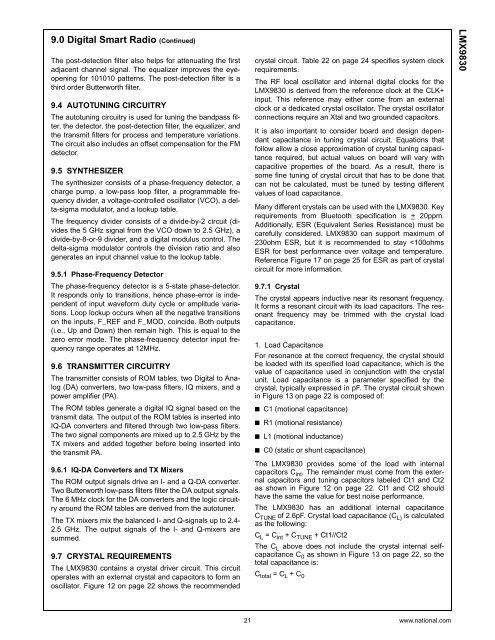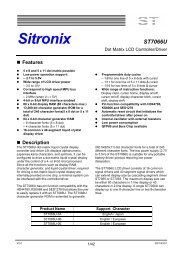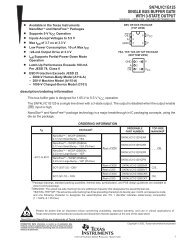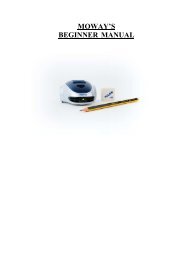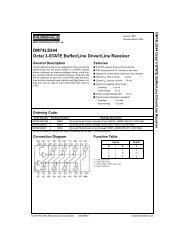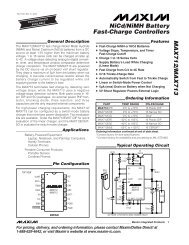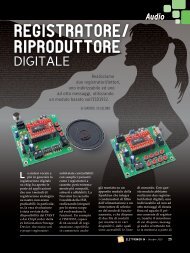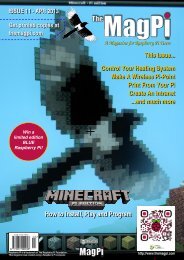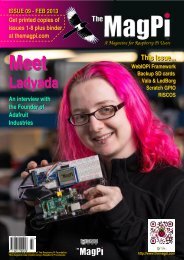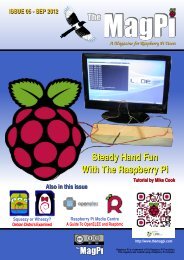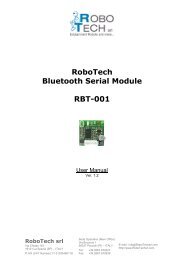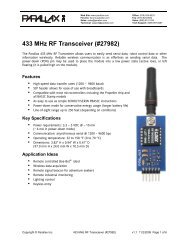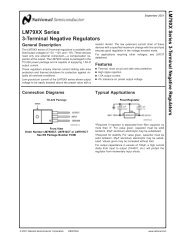Create successful ePaper yourself
Turn your PDF publications into a flip-book with our unique Google optimized e-Paper software.
9.0 Digital Smart Radio (Continued)The post-detection filter also helps for attenuating the firstadjacent channel signal. The equalizer improves the eyeopeningfor 101010 patterns. The post-detection filter is athird order Butterworth filter.9.4 AUTOTUNING CIRCUITRYThe autotuning circuitry is used for tuning the bandpass filter,the detector, the post-detection filter, the equalizer, andthe transmit filters for process and temperature variations.The circuit also includes an offset compensation for the FMdetector.9.5 SYNTHESIZERThe synthesizer consists of a phase-frequency detector, acharge pump, a low-pass loop filter, a programmable frequencydivider, a voltage-controlled oscillator (VCO), a delta-sigmamodulator, and a lookup table.The frequency divider consists of a divide-by-2 circuit (dividesthe 5 GHz signal from the VCO down to 2.5 GHz), adivide-by-8-or-9 divider, and a digital modulus control. Thedelta-sigma modulator controls the division ratio and alsogenerates an input channel value to the lookup table.9.5.1 Phase-Frequency DetectorThe phase-frequency detector is a 5-state phase-detector.It responds only to transitions, hence phase-error is independentof input waveform duty cycle or amplitude variations.Loop lockup occurs when all the negative transitionson the inputs, F_REF and F_MOD, coincide. Both outputs(i.e., Up and Down) then remain high. This is equal to thezero error mode. The phase-frequency detector input frequencyrange operates at 12MHz.9.6 TRANSMITTER CIRCUITRYThe transmitter consists of ROM tables, two Digital to Analog(DA) converters, two low-pass filters, IQ mixers, and apower amplifier (PA).The ROM tables generate a digital IQ signal based on thetransmit data. The output of the ROM tables is inserted intoIQ-DA converters and filtered through two low-pass filters.The two signal components are mixed up to 2.5 GHz by theTX mixers and added together before being inserted intothe transmit PA.9.6.1 IQ-DA Converters and TX MixersThe ROM output signals drive an I- and a Q-DA converter.Two Butterworth low-pass filters filter the DA output signals.The 6 MHz clock for the DA converters and the logic circuitryaround the ROM tables are derived from the autotuner.The TX mixers mix the balanced I- and Q-signals up to 2.4-2.5 GHz. The output signals of the I- and Q-mixers aresummed.9.7 CRYSTAL REQUIREMENTSThe <strong>LMX9830</strong> contains a crystal driver circuit. This circuitoperates with an external crystal and capacitors to form anoscillator. Figure 12 on page 22 shows the recommendedcrystal circuit. Table 22 on page 24 specifies system clockrequirements.The RF local oscillator and internal digital clocks for the<strong>LMX9830</strong> is derived from the reference clock at the CLK+input. This reference may either come from an externalclock or a dedicated crystal oscillator. The crystal oscillatorconnections require an Xtal and two grounded capacitors.It is also important to consider board and design dependantcapacitance in tuning crystal circuit. Equations thatfollow allow a close approximation of crystal tuning capacitancerequired, but actual values on board will vary withcapacitive properties of the board. As a result, there issome fine tuning of crystal circuit that has to be done thatcan not be calculated, must be tuned by testing differentvalues of load capacitance.Many different crystals can be used with the <strong>LMX9830</strong>. Keyrequirements from Bluetooth specification is + 20ppm.Additionally, ESR (Equivalent Series Resistance) must becarefully considered. <strong>LMX9830</strong> can support maximum of230ohm ESR, but it is recommended to stay


